The world is full of tales of mythical monsters, fairy creatures and legendary beasts. Some were inspired by real animals, others are just symbols, embodying our deepest fears.
Monsters live and thrive in our imaginations, and since the Middle Ages have brought cultures together and helped overcome our true fears. Here are 10 mythical monsters that are not as famous as their popular counterparts.
10. Soukoyant
Soukoyant is a kind of werewolf, belongs to the class of Caribbean spirits. During the day, the soukoyant appears in the form of a weak old woman, and at night she sheds her skin, hides it in a mortar, turns into ball lightning and flies in this form across the sky in search of victims. According to myths, a soukoyant sucks blood from its victims and then gives it to demons in exchange for evil powers. As with European vampire myths, if the sucoyant drinks too much blood, the victim will either die or turn into a monster as well. To kill a soukoyant, the skin of the monster in the mortar must be sprinkled with salt, and it will disappear with the onset of dawn.
9. Kelpie
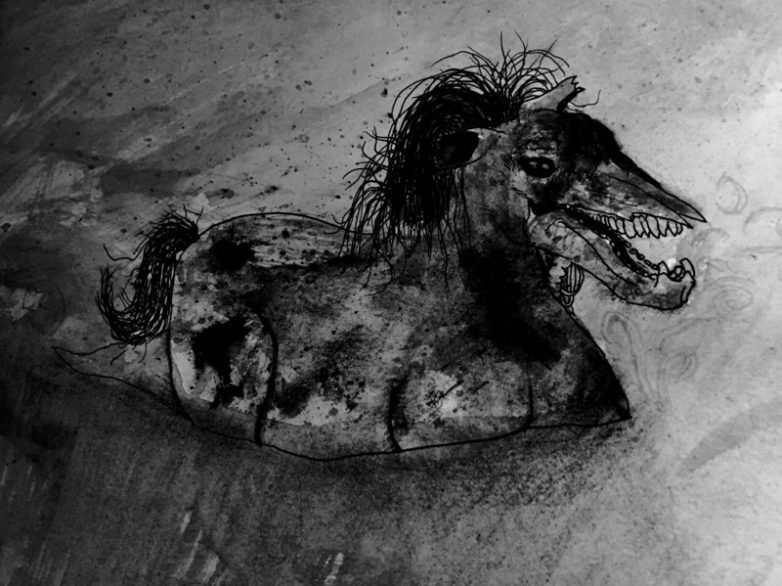
Kelpie is a water werewolf spirit that inhabits the rivers and lakes of Scotland. Although the kelpie is usually described as looking like a horse, it can also take on human form- at least, this is what the works of the classical English artist Herbert James Draper. According to folklorist Walter Gregor, kelpies lure people onto their backs and then dive underwater with their riders and tear them to pieces. Be that as it may, this myth is a great way to keep kids out of the water and warn women about how dangerous beautiful strangers can be.
8. Basilisk
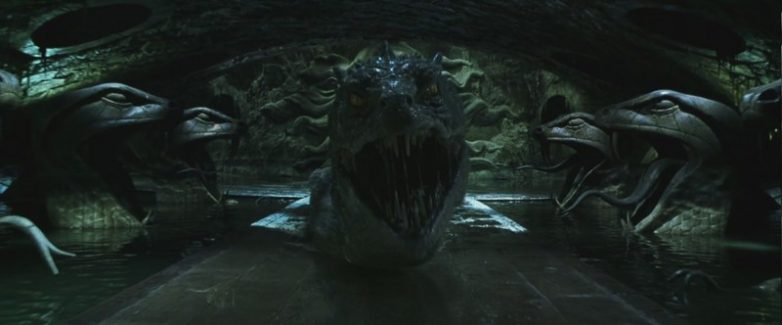
The basilisk is most often described as a snake with a comb, although sometimes there are descriptions of a rooster with a snake's tail. He kills birds with his fiery breath, people with his gaze, and other creatures with a simple hiss. According to legends, the creature is born from a snake egg incubated by a rooster. From Greek, his name is translated as "little king", and therefore the basilisk is called the king of snakes. The monster was blamed for the plague and murders during the Middle Ages.
7. Asmodeus

Asmodeus is a tempting demon best known for the book of Tobit where he is the main antagonist. In the book, he is obsessed with Sarah, and kills seven of her husbands before the marriage is consummated. Asmodeus is also mentioned in other Talmudic legends, including the story of the construction of Solomon's temple. Some folklorists suggest that Asmodeus is the son of Lilith and Adam. It is he who is responsible for the perversion of sexual desires. According to Jewish myths, those who succumb to these desires are doomed to eternal torment in hell.
6. Yorogumo
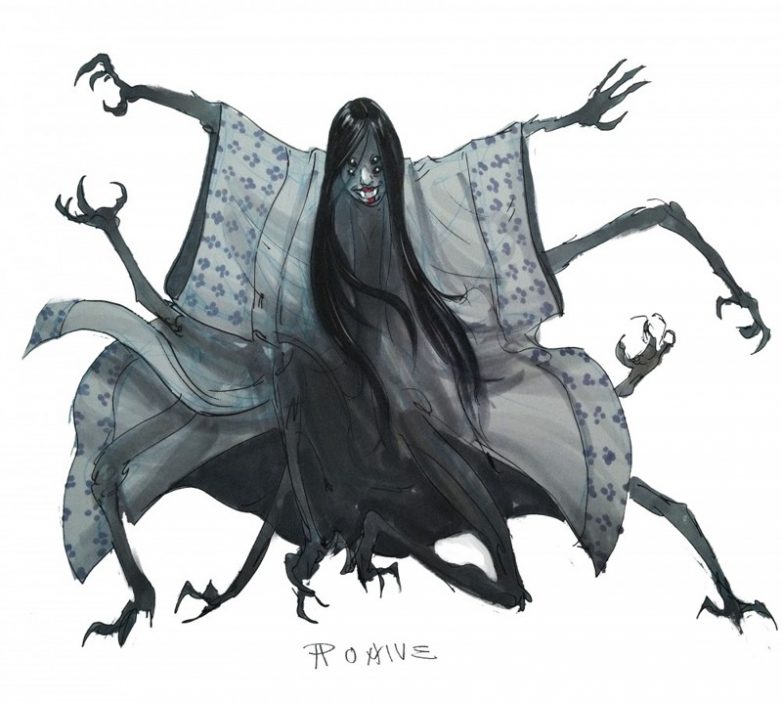
There are more strange cryptozoological creatures in Japan than the X-Files has shown in all seasons. But perhaps the most unusual monster is the Yorogumo, or "spider harlot." The legend of Yorogumo dates back to the Edo period. It is assumed that when the spider reaches 400 years of age, it acquires magical abilities. In most stories, the spider takes the form beautiful woman, lures men to her home by playing the lute, and then weaves them in cobwebs and devours them.
5. Black Annis
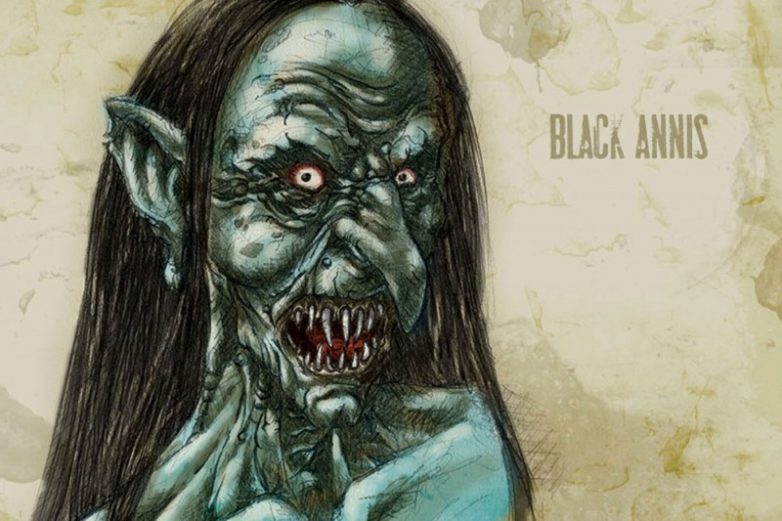
The hag of English folklore Black Annis is an old hag with a blue face and iron claws who terrorized the peasants of Leicestershire. According to the legends, she still lives in a cave in Dane Hills, and at night she wanders the hollow in search of children. When she manages to catch a child, she tans its skin by hanging it from a tree and then wears it around her waist. Needless to say, parents are happy to remember the image of Black Annis when children misbehave.
4. Nabau

In 2009, a research team in Borneo caught on film what appeared to be a 50-meter snake swimming down the Baleh River. The debate about whether the photographs are reliable is still ongoing - many believe that the "giant snake" is too reminiscent of a log or a speedboat. Be that as it may, the locals insist that it is none other than Nabau, an ancient dragon-like monster from Indonesian folklore. According to myths, Nabau exceeds 50 meters in length, has a dragon's head with seven nostrils, and can take the form of ordinary animals.
3. Dullahan
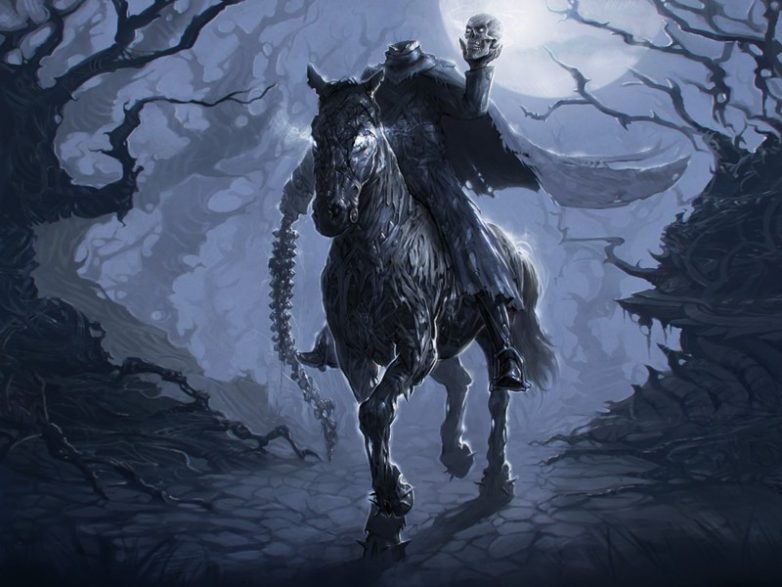
Many are familiar with Washington Irving's short story "The Legend of Sleepy Hollow" and the story of the headless horseman. Irish Dullahan, or " dark man is the forerunner of the headless Hessian cavalryman who pursued Ichabod Crane in the story. Celtic myths say that the Dullahan is a harbinger of death. He appears on a huge black horse with glowing eyes, holding his own head under his arm. In some versions of the story, the Dullahan names the person who is about to die, while others claim that he marks the person by pouring a bucket of blood over him. Like many other monsters and mythical creatures, the Dullahan has one weakness: gold.
2. Red caps

Redcaps are vicious goblins that live on the border of Scotland and England. According to folklore, they dwell in ruined castles and kill wayward travelers, most often by throwing stones from cliffs on them, after which they stain their caps in the blood of the victim. They need to kill as often as possible, because they die when the blood on their caps dries up. Most often they are depicted as old men with red eyes, large teeth and claws, sometimes with a spear in their hands. They are faster and stronger than people. The only way to escape the red cap is to shout out a Bible quote.
1. Brahmaparusha

Brahmaparusha is not just some ordinary vampire. The evil spirit comes from Indian mythology and is known for its passion for human brains. Unlike the noble, dapper vampires that flooded Romania, the brahmaparusha is a grotesque monster. He wraps the intestines of his victims around his own neck and head and wears them like a turban. He also carries around a human skull as an accessory. When a brahmaparusha kills another victim, he pours her blood into her own skull and drinks it. However, he does not stop there: the monster then turns on the Hannibal Lecter mode and treats itself to the brains of the victim. How he relates to beans and a good Chianti, history is silent.
Human activities are mainly related to land. That is why everything related to water raises many questions and assumptions. Water is a completely different world, sometimes incomprehensible and very often inaccessible. The creatures that live in the depths of the seas and oceans are so different from those who live on land that they can cause not only surprise, but very often fear.
In ancient times, people were convinced that water was fraught with danger. All these fears and conjectures are reflected in legends and myths.
Despite the fact that man managed to descend into the Mariana Trench, which is considered the deepest place on the planet, nevertheless, he knows practically nothing about the terrible and terrible monsters that live at the bottom of the ocean. Sailors often mentioned in their stories about sea monsters, which dragged large ships under water. On old maps you can see images of giant octopuses, newts, snakes and whales. Myths that talk about sea monsters are found in almost all peoples who have dealt with water. And almost all descriptions indicate that the monsters had lion's mouths, huge tentacles and luminous eyes.
With the beginning of the development of navigation, when people began to travel across the continents, gradually the fear of water disappeared, but stories about sea monsters still arose. Over time, such stories became less and less, but even in modern world, per century scientific progress, such stories sometimes occur.
It should be noted that, as a rule, a wide variety of creatures were mentioned in ancient legends. But to answer the question of whether they really existed, scientists cannot. Some researchers are sure that most of these stories are memories of pterodactyls, dinosaurs and plesiosaurs, who managed to survive until the time of the appearance of man.
Probably one of the most famous ancient sea monsters is the Leviathan. This monster can be found in the Old Testament. His description is a mixture of fear and delight. This is a beautiful, proud creature, which at the same time is associated with Satan and inspires fear.
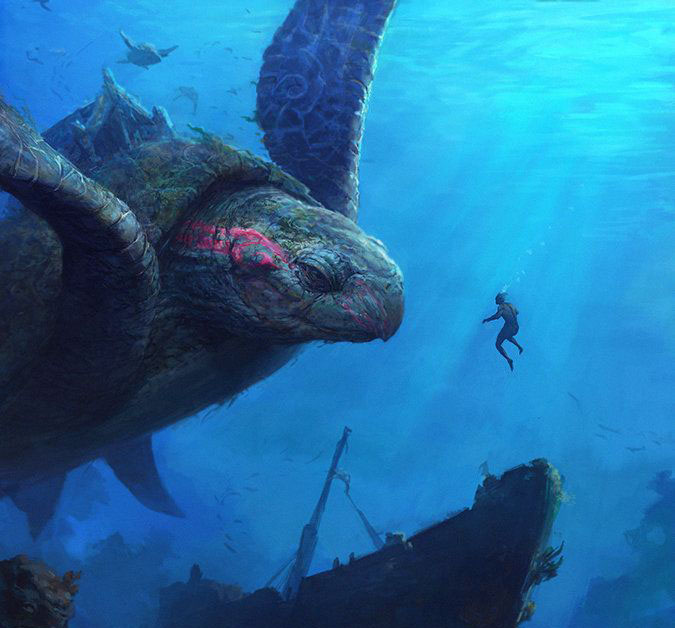
This image appeared in the book of Job, and turned out to be so vivid that the name Leviathan became a household name. A similar character breathing fire is found in many books, films and songs, and even in computer games.
Scientists say that it cannot be ruled out that Leviathan actually existed, since such legends could not be born on empty place, something must have provoked the creators of the Bible to create such an image, some kind of prototype. On the other hand, everything written in Holy Scripture, cannot be taken literally, because its authors preferred allegory. The authors did not have to meet in real life with a similar monster - it is quite possible that the image of this terrible monster was taken only as an illustration of a certain phenomenon. But the image appeared for a reason, so it could be preceded by meetings with large lizards.
Could it be that the prehistoric monsters that lived in the seas and oceans managed to survive until the appearance of man on the planet and were noticed by him? Such a development of events cannot be ruled out at all. Scientists have not yet been able to establish the cause of the disappearance of the ancient giant lizards, therefore, it is impossible that some of them survived and bred offspring. It could also be sea monsters that, at great depths, could survive those cataclysms that, as a result, led to the death of ancient lizards.
Science does not know what is happening in the depths of the world's oceans, so it cannot be ruled out that ancient lizards can exist even now. They may well occasionally appear on the surface, from time to time meeting with a person. It is also likely that mutants could appear in the depths of the sea, which are equally similar to ancient lizards and modern animals. This, at least, can explain the origin of the legends about creatures of enormous growth that emerge from the depths of the sea and which are called "sea monks".
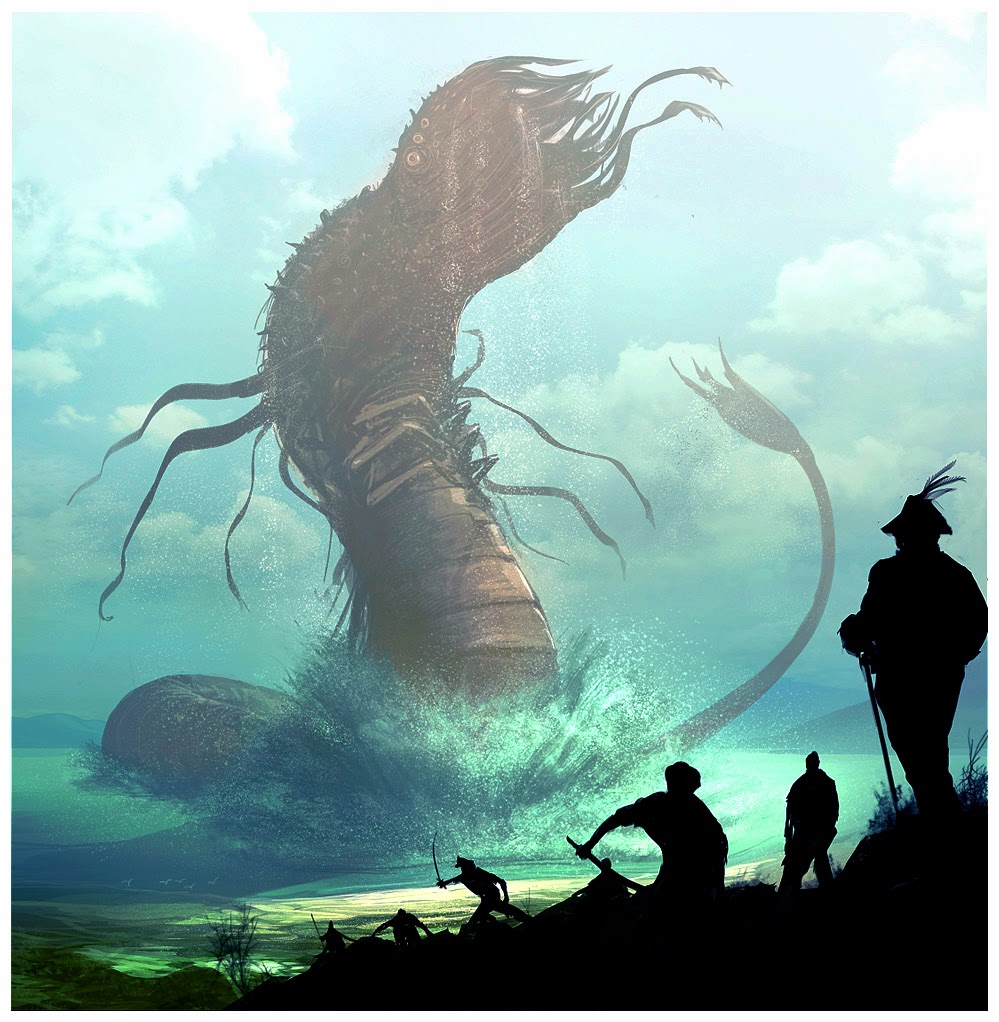
IN medieval legends there are stories of creatures resembling mermaids. They had a fish tail instead of legs and hands instead of fins. They are often seen on the northern European coasts. The German theologian Megenberg told the legend of the "sea monks" who went to Coast. These creatures danced, attracting the attention of people. The dance was so beautiful and mesmerizing that people lost their vigilance and came very close to these creatures. "Monks" grabbed the unwary and ate them in front of the rest. And in the last century on the territory of Denmark, even managed to find the corpse of the "sea monk". His height was 15 meters. The creature's remains were sent to Copenhagen, where it was made sensational statement: This creature is a common cuttlefish with ten tentacles.
However, scientists do not exclude that during the Middle Ages, certain types of sharks or walrus representatives could be mistaken for “monks”. True, in this case it is not entirely clear how they could arrange dances on land. Cuttlefish do not have enough strength to drag an adult under water, sharks do not leave the water and react only to the smell of blood, and walruses do not attack people. Therefore, it is quite possible that in the legends we are talking about some animals unknown to modern science.
Another variety of sea monsters became known in 1522, when the Dutch scientist Oddemansa spoke about gigantic snakes that lived deep under water. These monsters were rarely seen by people - in one place they were seen only once every ten years for three centuries. However, since the beginning of the nineteenth century, the number of reported cases has increased dramatically - in one year, this creature appeared to sailors as many as 28 times. Scientists cannot say what caused such activity, but at the same time they suggest that sea creatures simply did not like the presence of ships in the sea.
Already in the last century, these monsters have become less active, although even now there are more than enough stories about giant snakes. The most interesting thing is that none of the eyewitnesses managed to take a picture mysterious creature. Therefore, you can leave an idea of \u200b\u200bhow giant snakes actually looked like only from the stories of sailors.
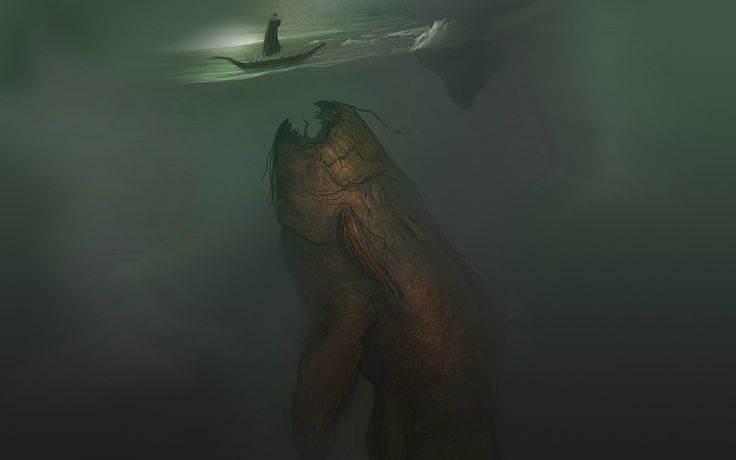
At the same time, scientists say that in the ocean waters in the Triassic period, Tanistofeus lizards were found, which had a short body and a very long neck. According to paleontologists, these creatures lived on land, but soon moved to the depths of the sea. This lizard can be mistaken for a snake of gigantic size, assuming that these creatures could survive to our time.
In history, legends about immersion in sea depths Alexander the Great in a glass barrel. Allegedly, he saw a huge monster at the bottom, which swam around the barrel for three days and three nights. Of course, one can argue about the veracity and originality of this story. Moreover, there are quite a lot of similar legends in ancient texts. So, in particular, ancient texts contain a legend that the Assyrian king Sargan II saw a giant snake. A terrible monster attacked the Roman legionnaires, they used a catapult and killed the monster. It was later skinned and taken to Rome to be shown to the general public. The length of the trophy reached 20 steps.
There are references to mysterious sea monsters and Chinese sources. So, in one of the manuscripts dating back to the twelfth century, you can find a story about the existence of a certain dragon. According to the author of the text, he saw the skeleton of this creature in the court pantry. The fins, limbs, torso and tail were completely intact, only the horns were cut off. Outwardly, the skeleton was very reminiscent of dragons, the images of which existed at that time.
The Central African tribe of pygmies still have legends about the terrible monster "mokele-mbembe". According to eyewitnesses, this is a cross between a dragon and an elephant. On the territory of Zambia, according to legend, there lives a creature resembling a dinosaur, which the local population calls the "devourer of hippos." This creature has a neck and head like a giant lizard. And the famous hunter Jordan even had to meet him. As the hunter notes, this creature has the body of a hippopotamus covered with bone scales, the head of a crocodile. Interestingly, Jordan's guides fully confirmed his story.
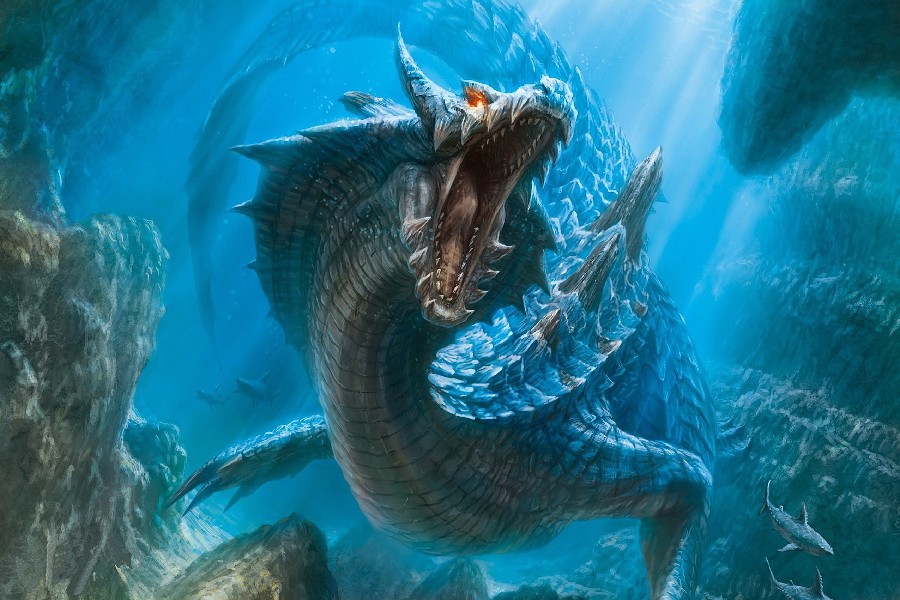
But the head of one of the scientific expeditions, Marcellin Anyana, even managed to film a mysterious animal. It happened on Lake Tele. Three hundred meters from the shore in the water, the scientist saw a snake head on a massive neck. This creature "posed" for about 10 minutes, after which it disappeared into the water. According to Anyanya, this animal is very similar in appearance to the brontosaurus, a gigantic herbivore that became extinct about 70 million years ago.
Relatively recently created in Germany, the deep-sea submersible "Hyfish" almost died after meeting with one of the sea monsters. The device sank in the area of the Mariana Trench to a depth of about 7 kilometers, but later it could not rise to the surface. Then the hydronauts turned on the thermal imager to see what was preventing the device and were shocked by what they saw: a monster resembling a lizard clung to the body of the device. Fortunately, such an opportunity was foreseen in advance: with the help of an electric gun with a large current charge, we managed to get rid of the monster.
There are many such stories. To explain what kind of creatures they are, and where they came from, modern science cannot yet. From this it follows that in the ocean there are still many mysteries and mysteries that scientists have yet to unravel. modern science tends to the stars, while the depths of the sea keep not fewer mysteries than space. Deep sea diving will be full of surprises for a very long time to come. But perhaps someday these mysteries will still be unraveled ...
Police, gypsies, Babai, an uncle with a bag - in any society where children are born, there are both real and mythical characters that scare children if they misbehave.
In South America, it's good, and there are also a lot of children. As well as adults with childish pious souls. Moreover, the continent is full of natural extremes - mountains of such a height, rivers of such depth, impenetrable forests and impassable something else. In general, the notorious Africa “nervously smokes on the sidelines” of its weeds. Such a variety of nature hostile to sapiens gave rise to volumes of legends about monsters more terrible than a policeman with a sack or a gypsy riding a gray top that bites the barrel. monster legends South America roam from people to people, so many of the monsters can be proud of the assortment of names and nicknames.
In the vile guise of a yakumama, we are dealing with an ancient water monster that lives in the Amazon River. This is a giant female snake with a horned head, sometimes humanoid. According to some fantastic data, the body length of the monster reaches 50-60 meters.

Judging by the legends in which the yakumama draws a full mouth of water in order to knock down its breakfast or lunch, the local Indians, in the form of a reptile thereof, crossed the famous local spatter fish and.

At present, scientists, far from the lower mythology of savages, know that in the Amazon jungle, giant anacondas grow up to 12 meters in length, although infrequently. And if someone suddenly meets a yakuamama and wants to measure it, then the curious vagabond will have to take the measurement data with him to the next world.
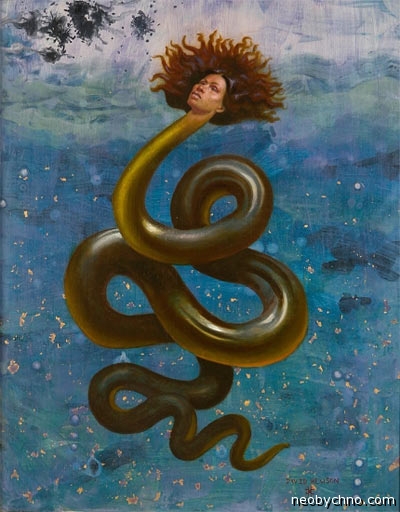
2. Cuero
"El Cuero" in translation means "cow's skin". A Chilean monster with that name lives in Lake Lacar in the Andes. It looks like a flattened cattle skin with a hairless head and vertebral bones, i.e. ridge.

The appearance of the cuero in the mythology of the Americans is probably associated with cases of encounters between the natives and gigantic stingrays. However, the cuero is larger than any stingray, with stalked eyes and full of sharp claws. The monster feeds on the blood of its victims.
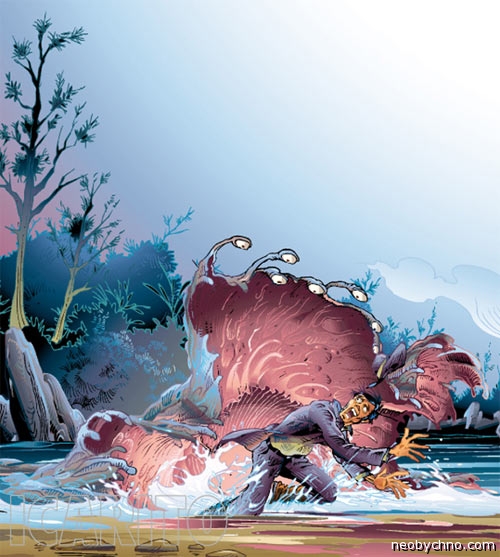
In the Amazonian region, people call a similar monster Hueke-Hueke, but this kind of living nightmare supposedly does not suck the blood. And more often than usual, it turns out to be a completely harmless stingray in the order of the size.
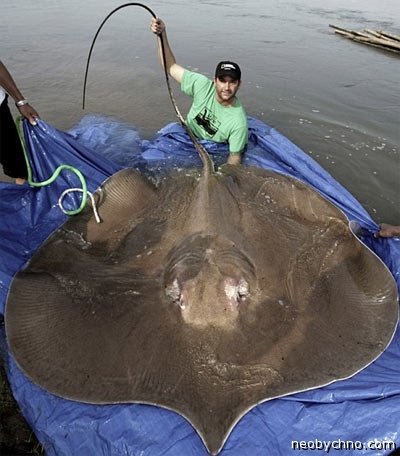
3 Crocodile Man
El Ombre Caiman (i.e. "alligator man") is a figment of the imagination of the inhabitants of the northern coast of Colombia. The legend tells of an anthropomorphic reptile monster who, in ancient times, worked as a seller in a shop and, in appearance, was a completely normal Colombian mestizo.
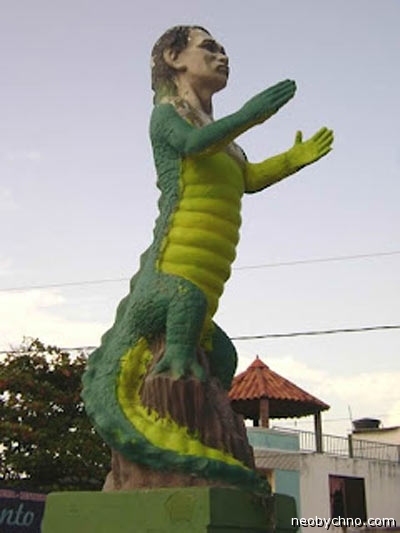
One day, the shopkeeper fell in love with a young woman named Roque Lina, the daughter of a rice merchant. The girl's father opposed this love and forbade young people to see each other. But on the bank of the river, where Roque Lina used to bathe in the nude, there was a restaurant where the enamored shopkeeper got into the habit of going to eat rice with coconut milk and rum. One day when a girl came to water procedures, having eaten rice and drunk on rum muchacho decided to dive into the river to hug and kiss his passion. But the river gods judged in their own way and the poor guy turned into an alligator.
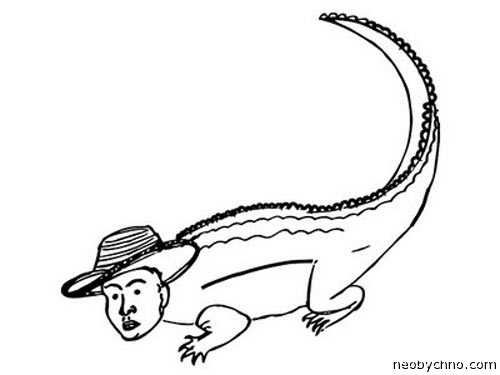
Since the shopkeeper's head remained human, the girl allowed herself to be kissed. Coming ashore, the lover returned to human form. This happened four more times, until dudes with guns became interested in miraculous transformations. Then the man-crocodile, in order not to part with Roque Lina, dragged her to the bottom of the river, as befits toothy predators.
Since then, Colombian men have had a stupid prejudice in their heads - if someone doesn’t eat a portion of rice in a tavern, then El Ombre Cayman will come and steal the wife of the undernourished, drag him under a snag and kiss him to a multiple orgasm.
4. Encantado
This beast is also known as Mohana and is a freshwater dolphin from the Amazon basin, but not harmlessly friendly, but endowed with evil spirits.
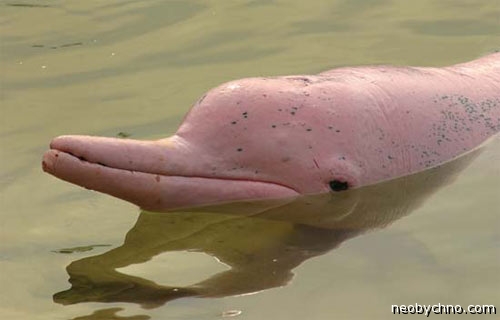
"Encantado" means "enchanted". This is a werewolf dolphin that can turn into a human. Encantado is an inquisitive beast and loves to be among people, especially during lush noisy holidays. Sometimes, as musicians, werewolves remain in human society for years.
![]()
Everything would be fine, but werewolf dolphins have one bad manner. If Encantado likes a woman, he hypnotizes her and drags her into his secret hole. Sometimes the captives manage to escape, but they are pregnant by a dolphin and give birth to the same magical werewolves as Encantado.

Primacy Humanoid. A South American variety of Bigfoot, described by the famous traveler Percy Fawcett shortly before his mysterious disappearance in company with his eldest son. Have the brave explorers been devoured by an unknown hairy freak?
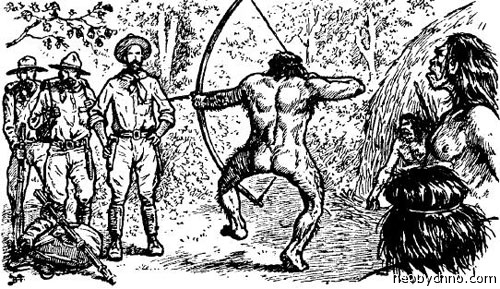
Unlike the great apes, the maricoxi uses a bow, arrows, and spears. But he does not know how to speak articulately, that is, he is stupid. If you make a shot from a gun or pistol, the monster gives a screech.
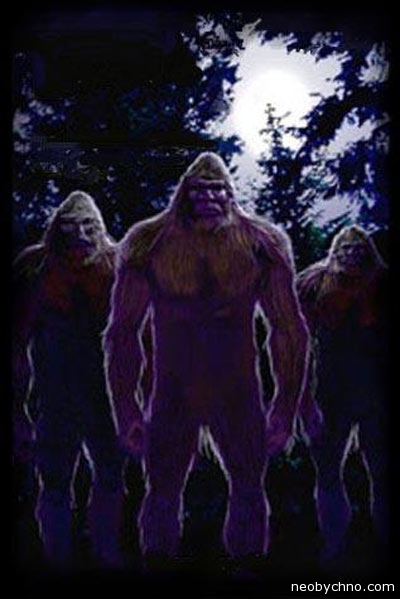
Science and pseudoscience describe different types marikoksi - from a dwarf, similar to a pygmy from Africa, to a furry giant monster 3.5 meters tall.
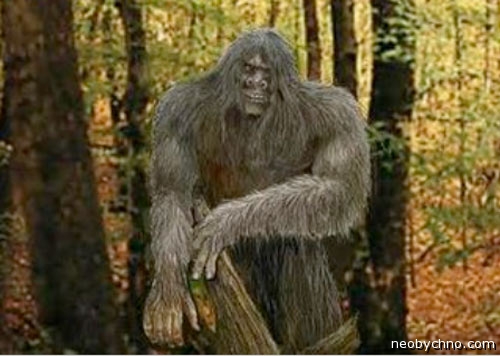
6. Huallepen
Chimera, born of the fears that live in the craniums of the longest country in the world, i.e. Chile. Huallepen (or Guallipen) vaguely looks like a bull, but incomparably uglier than domestic cattle. Chileans say that if a pregnant woman throws at least one glance at Huallepen, then the fetus in her womb will become a freak.

The monster lives in the rivers and lakes of Chile, has a beef head, a mutton body and flippers adapted for swimming. During the mating season, they attack cattle that come to the watering hole, mate with them, as a result of which unknown animals or simply mutants are born in cows, goats and sheep, like these:
![]()
7. Madremonte
La Madremonte (i.e. "Mother Mountain") is a Colombian spirit female, similar to the Irish Banshee, a goggle-eyed woman who lives in the forest. Her clothes are made of leaves and moss.

Mother Mountain controls the weather and, like the Russian goblin, makes the traveler get lost in the forest. Approaching it is problematic, usually wanderers can only listen to the cries and howls of Madremont in the jungle. And then at night. Good night you dear!
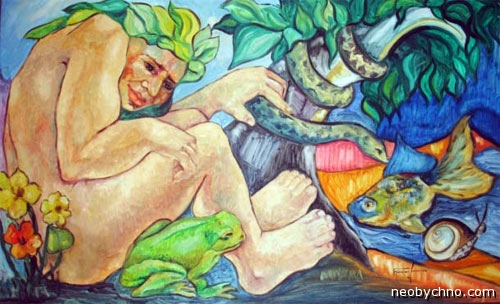
Mythology is filled to the brim with monsters - they were part of human culture from our earliest days. Alas, nowadays we have vampires who glisten in the sun and werewolves who have conflicting emotions. Nevertheless, during the time of our ancestors, probably some of the most scary monsters. Therefore, we present to your attention ten monsters from ancient mythology who you definitely wouldn't want to meet.
10. Laestrygonians (Greek mythology)
If you've ever read Homer's Odyssey, you know about these terrible creatures. For those of you who have not read the Odyssey, we will describe them in three words. Unfriendly. Cannibals. Giants. Not the ones you want to meet in a dark alley.
According to legend, the Laestrygonians lived on the island of Lamos (Lamos), in a city called Telepylos. When the hero Odysseus arrives on Lamos, his fleet is bombarded with boulders, and when he enters the harbor, three of his scouts are eaten while exploring the city. As they try to swim away, you guessed it, the Laestrygons start throwing rocks at their ships. Oh yes, they impale some of Odysseus' men on spears. It is difficult to say which fate is worse ...
9. Dybbuk (Jewish mythology)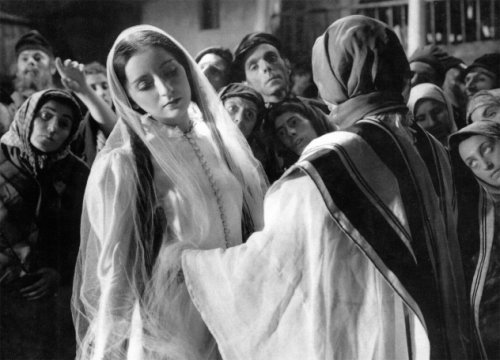
The dybbuk is the Hebrew version of the demon in their myths. If you think that an ordinary demon is bad, then the Dybbuk is much worse. The creature clings to the souls of the good, honest people and causes destruction and chaos wherever it appears.
On his own, the Dybbuk is a broken soul, desperate to find something to support himself. But the being never knows what is going on and can only cause confusion. Unlike the other monsters on this list, the Dybbuk does not have physical form which might make you feel even more sorry for the poor thing. Well, that is if you can feel sorry for a broken soul that kills people from the inside.
8. Nachzehrer (German mythology)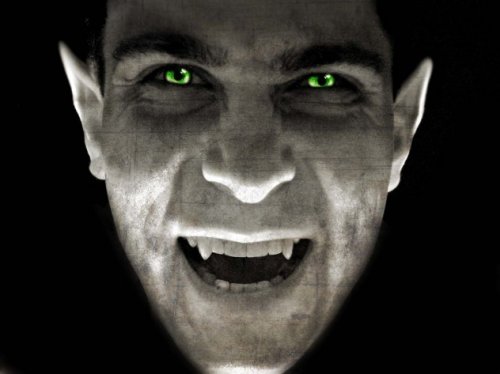
In an age where centuries-old vampires experience teenage existential angst and bloodlust on top of all their troubles, it's good to have a refreshing change in the form of the vampire family, the Nachzehrer. Some weird mixture of vampire and ghoul, the Nachzehrer is a soul-sucking monster that is endemic to the northern regions of Germany (another place to cross off your travel list). Nachzehrer rises from the grave to devour his own relatives. Nachzehrer can also kill you by playing on church bells whose sound brings death to all who hear it. He can also kill you by making you face his shadow. It definitely sounds scarier than glittering teenagers.
7. Gugalanna (Sumerian mythology)
The days of our ancestors were filled with numerous epics - great poems and tales of mighty heroes and kings. One of these epics was the Epic of Gilgamesh, which told of a monster that broke through the heavens, killed thousands of people and was only stopped when Gilgamesh and Enkidu came to the city.
The fact is that this monster was a god who is familiar to us as the sign of the zodiac "Taurus". Why did he break through the skies and kill thousands of people? This happened because the great king Gilgamesh refused the advances of the goddess Inanna, so she sent a monstrous god to kill him. In myths, the reasons behind actions can be surprisingly simple.
6. Ichneumon (Medieval mythology)
While mongooses aren't technically monsters (unless you piss them off, of course), their mythological counterpart isn't all that simple and he's not all that cute either. According to legend, Ichneumon was the only true enemy of the dragon, whose cunning and wisdom matched his harsh power and anger, and made him the most famous monster in Europe.
So how could Ichneumon defeat a dragon whose reputation conjures up images of maidens, burning villages, and mountains of gold? He crawled inside it, of course! Ichneumon covered himself in mud, and (depending on the medieval source you're reading) crawled inside the dragon (or some unfortunate crocodile) through the nostrils and gnawed it from the inside. Not very glamorous, but how effective!
5. Strigoi (Romanian mythology)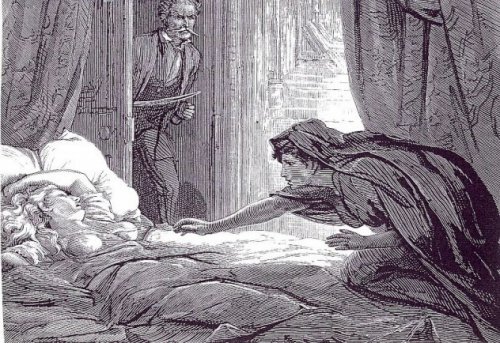
Romania is well known for its vampires, especially infamous famous count Dracula, but it is also the country where the myth of the creature that may be the granddaddy of vampire stories, the Strigoi, originated. Just his name makes you shudder, doesn't it?
The strigoi is a martyred soul that rises from the grave, ready to devour your blood and roam the earth once more. The strigoi can also turn invisible and transform into an animal. Strigoi, beings of demonic origin, are so feared in Romania that even today there are cases where graves are dug up to eliminate the threat of vampires.
4. Were-Tiger (Chinese mythology)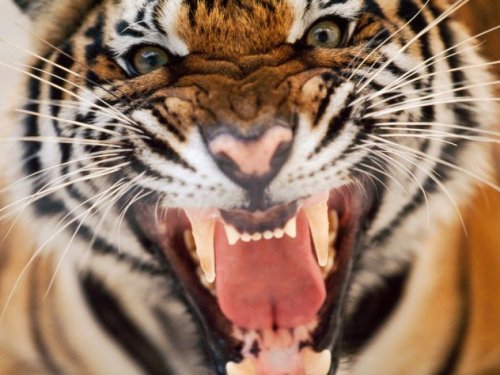
Sure, we've all heard of werewolf werewolves, but werewolf tiger sounds a lot more interesting, doesn't it? According to legend, in order to become a werewolf tiger, one must suffer from a unique curse that has been passed down from generation to generation, or simply greatly anger an ancient spirit.
Other myths talk about how all other races, except for the Chinese, were actually animals that, in the mists of time, forgot who they were, and that tigers were one of them. According to another myth, in order to rise from the grave as a werewolf tiger, you need to be killed by a tiger. Regardless of how this creature appears, this is not at all what you would like to meet when lost in the Chinese jungle.
3. White Ladies (Dames Blanches) (French mythology)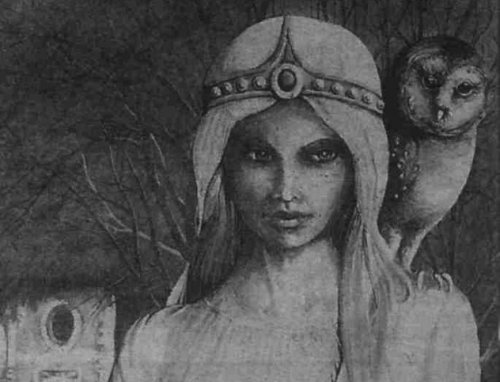
Even though they weren't actually monsters, the White Ladies weren't the friendliest creatures to meet on the bridge. Literally. They were beautiful women in white, who met stately young men who were trying to cross the bridge. If such a gentleman crossed her bridge, she would invite him to dance. If he agreed, she let him pass with a smile and never showed her dark side.
If he refused, she could throw him off a bridge, or order goblins, owls, cats, and creatures like them to taunt him for a while. Apparently they didn't like being rejected...
2. Black Annis (English mythology)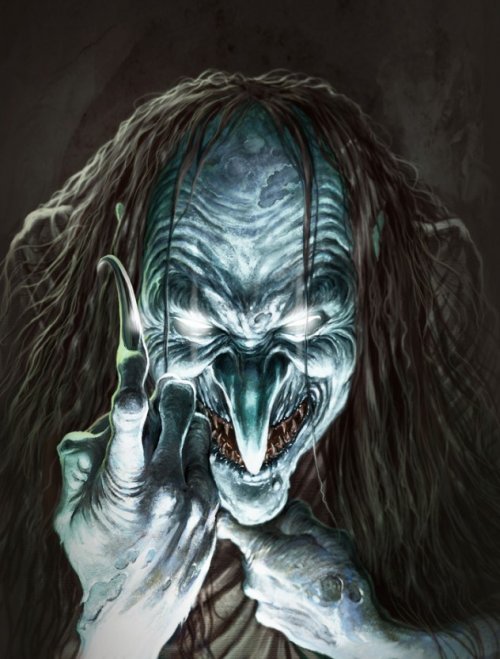
Another witch, Black Annis is the British equivalent of the Russian Baba Yaga. A malevolent, blue-skinned creature, she roamed around Leicestershire, England (not the scariest-sounding place in the world, but when you're a monstrous witch, you have few options) and enjoyed a menu of lambs and children. If she caught a child, she took off his skin and wore it around her waist.
Her home was a cave called Black Annis's Bower, which she carved into the rock with her iron claws, and her parents made the children behave by telling them that Black Annis would come and take them if they were naughty. Apparently the hour of standing in the corner was insufficient punishment for children of the 19th century.
1. Kashchei the Immortal (Slavic mythology)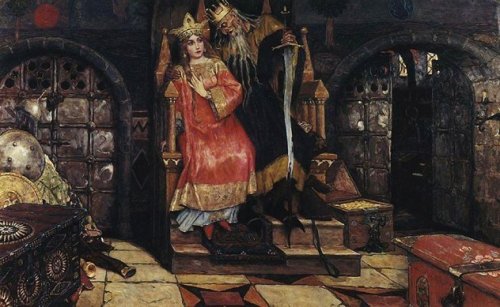
And so we come to the first place or monster that you least want to meet. Kashchei the Immortal is a classic mythological villain who steals the hero's wife, tries to woo her, but ultimately fails because he is a kidnapper, a sadist, and rather obnoxious. Because he can't die, no one can kill him... right?
Well, in fact, there is such a way: you need to destroy his soul. Unfortunately for the hero, he hid his soul in the form of a needle. The needle is inside the egg, which is in the duck, which, in turn, is in the hare. The hare itself is hidden in an iron box, which is buried under an oak tree growing on the mystical island of Buyan, house of three winds. This is not a walk for bread.
23.04.2016 20:25
Monster legends are found in cultures different people. Dragons, sea snakes, unknown animals with mystical power- all this became the basis a large number legends.
Let's get acquainted with several legends about unknown monsters. Was there ever a basis for such stories, or is it all scary tales? Who knows…
The Story of the Lambton Worm
This story happened in Northern England with the heir to Lambton Castle, John Lambton, who had a chance to face a monster. Hence the name of the monster - Lambton Worm.
One Sunday, when all people were supposed to be in the service in the church, John went fishing to the river Ware instead of the service. However, instead of fish, the heir to the castle took out a disgusting-looking worm from the waters of the river. To get rid of the vile creature, the man threw it into the well.
After this incident, circumstances developed in such a way that John had to leave the country. He spent seven whole years abroad and, of course, managed to forget about his strange and unpleasant find. However, the worm has not disappeared anywhere, moreover, over the years it has grown to a gigantic size.
 The monster climbed out of the well and returned to the river. The legend tells that during the day the worm rested on a rock located in the middle of the river, and at night it crawled ashore, where it hunted people and cattle. Local residents repeatedly tried to get rid of the monster, but their attempts were unsuccessful - no matter how much they tried to cut the worm into pieces, the parts grew back together.
The monster climbed out of the well and returned to the river. The legend tells that during the day the worm rested on a rock located in the middle of the river, and at night it crawled ashore, where it hunted people and cattle. Local residents repeatedly tried to get rid of the monster, but their attempts were unsuccessful - no matter how much they tried to cut the worm into pieces, the parts grew back together.
When John Lambton returned to his homeland, he learned about the horror that a vile monster brings to people. The man remembered his old find and firmly decided to get rid of this creature. He sought advice from a sorceress, who told John to put on his armor, covered with sharp spikes, and fight the monster in the water. The heir to the estate heeded her advice - putting on such armor, he went to the river. When he was in the water, the worm wrapped around the man's body, but the sharp spikes tore the monster's flesh into many small pieces, which were immediately carried away by the current, so the pieces could not grow together, and the terrible worm was finally defeated.
Legend of the Furry Beast

In many cultures, dragons are dangerouscreatures with huge fangs and claws, with the ability to spit fire. The legend of the Furry Beast, which has come down to us from the Middle Ages, tells the story of a dragon that attacked a French village.
In addition to the ability to kill his victims with fire, the Furry Beast had another terrible feature. The whole body of the animal was covered with thick hair, for which he got his name. Poisoned spikes flew out of the animal's fur, which killed local residents. The villagers were in despair. The beast destroyed fields, destroyed crops, ate small children and killed anyone who got in its way.
Once the Furry Beast killed a girl with whom a fearless young man was in love. Upon learning of the death of his beloved, the young man was furious and firmly decided to kill the beast. Pouncing on the dragon, he cut in half his tail, which was the only weak spot on the body of the animal, and the beast died immediately. The brave young man lost his beloved, but it was this pain and anger that helped him defeat the terrible monster, and thereby save the lives of hundreds of other people.
The Legend of the Giant Sea Serpent
This story took place in 1852, when two whaling ships set sail from the port of New Bedford and set sail on the waters of the Pacific Ocean.
The navigation of the ships, which bore the names "Monongahela" and "Rebecca Sims" was joint. Occurred while swimming in the ocean unusual meeting- the ships found a large animal that looked like a whale from a distance. The captain of the Monongahela, Mr. Seabury, inspired by the discovery, launched three boats that set off in pursuit of the animal. However, it was not a whale.
The captain managed to kill an unknown animal with a harpoon, which, writhing in death convulsions, sank two of the three boats. Examining the carcass of a dead creature, people were finally convinced that their find had nothing to do with a whale. It was a huge brownish-gray reptile, whose body turned out to be about 45 meters in length.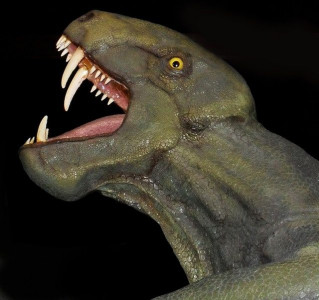
Due to its gigantic size, it was not possible to take the carcass of an animal with you.possible, so the sailors cut off only the head of an unknown creature, and the body was left in the water. According to the sailors, the head of the reptile looked impressive - dozens of sharp, curved teeth peeped out of the monster's mouth. The find was placed in a barrel with brine, which was in the hold of the Monongahela - in this way it was planned to deliver the trophy to the shore.
However, when the ships were returning home, there was strange story- on the way "Monongahela" mysteriously disappeared. The second ship, the Rebecca Sims, made it safely to port, but the people on that ship were unable to explain where the second ship had gone. Later, the wind brought the wreckage of the Monongahela to the coast of Alaska, but the barrel with the head of the monster was not among the wreckage. Thus, the terrible trophy was irretrievably lost. The only evidence of this story was the ship's log of the captain of the second ship, "Rebecca Sims" - in it the captain described this story, and thanks to him it has survived to this day.
The story of the sea monster from the mist
One day, in 1962, a severe storm broke out off the coast of Florida. He took to the open sea an inflatable raft of the US Air Force, on board of which there were five scuba divers. People were in a difficult situation, but they all managed to survive the storm.
When the sea calmed down, a thick fog appeared above the water, from which it was necessary to somehow get out. However, as it turned out, the fog was on main problem people in trouble. About an hour later, the scuba divers heard splashing water and a strange hiss. Appeared bad smell dead fish.
Suddenly, a large head rose out of the water, outwardly resembling the head of a turtle. The neck of the monster, or the part of its serpentine body that rose above the water, was about four meters long. Appearance The monsters frightened the scuba divers so much that a terrible panic began among the people - people screamed in horror and randomly rushed about, trying to find each other in the fog. Ultimately, four out of five scuba divers jumped or fell into the sea, where they found their death. Only one person from the team managed to escape, who told about the meeting with this terrible monster. The bodies of his other comrades could not be found.
Anastasia Cherkasova









